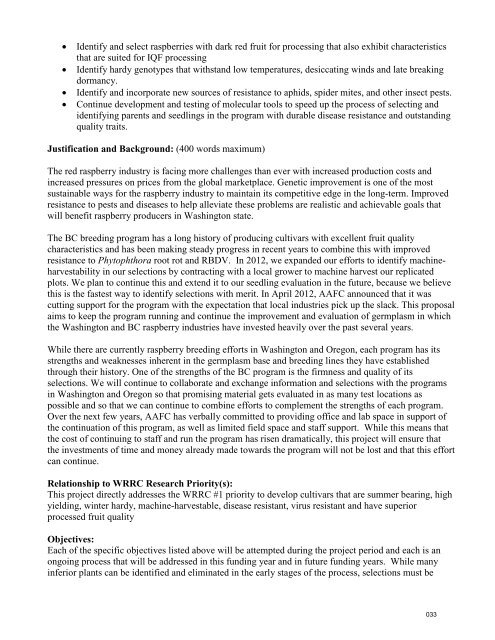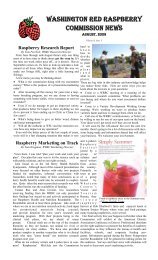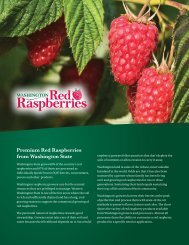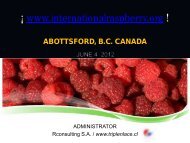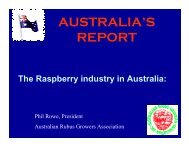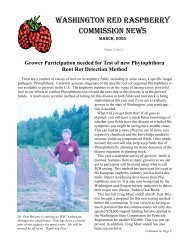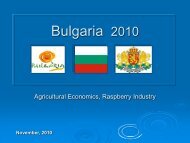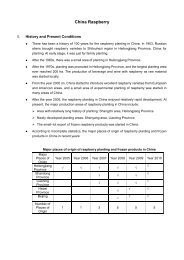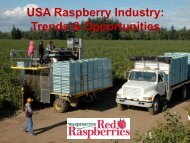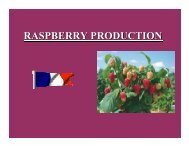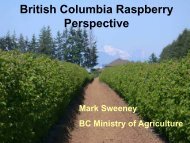2012 - Washington Red Raspberry Commission
2012 - Washington Red Raspberry Commission
2012 - Washington Red Raspberry Commission
You also want an ePaper? Increase the reach of your titles
YUMPU automatically turns print PDFs into web optimized ePapers that Google loves.
• Identify and select raspberries with dark red fruit for processing that also exhibit characteristics<br />
that are suited for IQF processing<br />
• Identify hardy genotypes that withstand low temperatures, desiccating winds and late breaking<br />
dormancy.<br />
• Identify and incorporate new sources of resistance to aphids, spider mites, and other insect pests.<br />
• Continue development and testing of molecular tools to speed up the process of selecting and<br />
identifying parents and seedlings in the program with durable disease resistance and outstanding<br />
quality traits.<br />
Justification and Background: (400 words maximum)<br />
The red raspberry industry is facing more challenges than ever with increased production costs and<br />
increased pressures on prices from the global marketplace. Genetic improvement is one of the most<br />
sustainable ways for the raspberry industry to maintain its competitive edge in the long-term. Improved<br />
resistance to pests and diseases to help alleviate these problems are realistic and achievable goals that<br />
will benefit raspberry producers in <strong>Washington</strong> state.<br />
The BC breeding program has a long history of producing cultivars with excellent fruit quality<br />
characteristics and has been making steady progress in recent years to combine this with improved<br />
resistance to Phytophthora root rot and RBDV. In <strong>2012</strong>, we expanded our efforts to identify machineharvestability<br />
in our selections by contracting with a local grower to machine harvest our replicated<br />
plots. We plan to continue this and extend it to our seedling evaluation in the future, because we believe<br />
this is the fastest way to identify selections with merit. In April <strong>2012</strong>, AAFC announced that it was<br />
cutting support for the program with the expectation that local industries pick up the slack. This proposal<br />
aims to keep the program running and continue the improvement and evaluation of germplasm in which<br />
the <strong>Washington</strong> and BC raspberry industries have invested heavily over the past several years.<br />
While there are currently raspberry breeding efforts in <strong>Washington</strong> and Oregon, each program has its<br />
strengths and weaknesses inherent in the germplasm base and breeding lines they have established<br />
through their history. One of the strengths of the BC program is the firmness and quality of its<br />
selections. We will continue to collaborate and exchange information and selections with the programs<br />
in <strong>Washington</strong> and Oregon so that promising material gets evaluated in as many test locations as<br />
possible and so that we can continue to combine efforts to complement the strengths of each program.<br />
Over the next few years, AAFC has verbally committed to providing office and lab space in support of<br />
the continuation of this program, as well as limited field space and staff support. While this means that<br />
the cost of continuing to staff and run the program has risen dramatically, this project will ensure that<br />
the investments of time and money already made towards the program will not be lost and that this effort<br />
can continue.<br />
Relationship to WRRC Research Priority(s):<br />
This project directly addresses the WRRC #1 priority to develop cultivars that are summer bearing, high<br />
yielding, winter hardy, machine-harvestable, disease resistant, virus resistant and have superior<br />
processed fruit quality<br />
Objectives:<br />
Each of the specific objectives listed above will be attempted during the project period and each is an<br />
ongoing process that will be addressed in this funding year and in future funding years. While many<br />
inferior plants can be identified and eliminated in the early stages of the process, selections must be<br />
033


